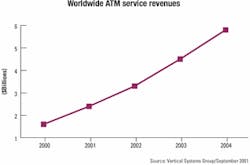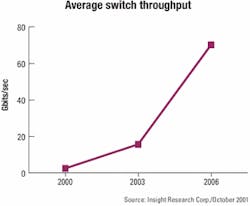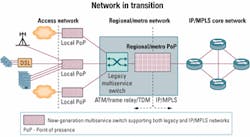ATM's prognosis
Will reductions in carrier capital spending shorten or prolong ATM's life expectancy?
CHAD DUNN, WaveSmith NetworksBeleaguered budgets in a shaky economy have led to serious reductions in carriers' capital expenditures. Tightened spending patterns could accelerate the demise of ATM by driving carriers to seek newer, more efficient broadband switching technologies. The primary downside to this scenario is that wholesale infrastructure changes cost piles of money that many carriers currently don't have, and such upgrades can be quite disruptive to existing services.
Another, perhaps more plausible, consequence is that a period of conservative spending could actually prolong ATM's life. In this case, risk-averse carriers will likely decide to nurture their existing bread-and-butter transport services and delay investments in replacement technologies, which are as yet largely unproven.
Neither alternative is ideal. Carriers don't want to mortgage their futures by not taking steps to prepare their infrastructures for the traffic volumes, new IP services, and streamlined networks that will be demanded eventually. On the other hand, they are understandably squeamish about making risky forklift upgrades to infrastructures based on new technology, most notably MPLS, which holds much promise but is still being put through its paces, and its return on investment potential is for now largely unproven.
A modified version of the second scenario, in which carriers begin a slow transition to MPLS while retaining their existing ATM infrastructures, at least in the access- and metro-network segments, is most likely to occur. That's because one thing is certain: Carriers are not apt to endanger the livelihood of the revenue-generating services, including private-line and packet-switched data, keeping them afloat today. The largest revenue-generator in the packet-switched data category is frame relay (FR) subscriber services, which is gaining on private lines for dominance in the data services market, at least in the United States. By the end of 2001, private-line data access connections will number 1.3 million in the U.S., with FR data access connections a heartbeat behind at 1.2 million, according market researcher Vertical Systems Group (Dedham, MA).FR access services represent a large impetus behind the pervasiveness of ATM aggregation in carriers' metro and backbone networks. In addition, ATM deployment for integrated access and high-speed data subscriber services in the access network is steadily gaining ground in its own right (see Figure 1).
Protect on the path to progress
The technology path carriers choose must protect these services, a fact of life that seems to bode favorably for continued investments in ATM technology. Indeed, there are both ATM and FR requests for proposals (RFPs) on the street today from most of the RBOCs and tier one carriers-basically, the telecommunications companies that have the greatest access to capital. While the incumbent service carriers are wisely continuing to hone their money-making services, carriers' network architects and chief technology officers (CTOs) want to prepare their organizations for the future. Exactly when "the future" will arrive is a matter of speculation, but when it does, it will bring with it the following requirements for multiservice WAN switches (requirements that the early-to-mid-1990s ATM switch technology in place today will be hard-pressed to deliver):
- The ability to migrate to an IP core. Running IP in the core will enable carriers to collapse infrastructure equipment layers, reduce costs, and streamline management. To get there, CTOs are eyeing IP/MPLS-capable infrastructures, because MPLS brings quality of service (QoS) to an IP network.
- Unprecedented switch throughput and port density to accommodate growth in traffic volumes. Insight Research Corp. (Parsipanny, NJ) expects the throughput capacity per switch to increase by a factor of 25 by 2006.
- Guaranteed 99.999% switch and network uptime to render integrated data/voice services as reliable as the public-switched telephone network.
So how does a carrier straddle both sets of needs, protecting existing profitable services and conserving capital outlay while managing to get into position for the future? With the capital market tightening, it's not practical for carriers to migrate to IP/MPLS with a wholesale upgrade. For one thing, MPLS is only about two years into a three-to-five-year initial implementation period. In uncertain economic times, telecom companies with profitable services other than IP services are having trouble justifying a reason to fiddle with their current formulas for success.
One way to satisfy both goals is to continue to invest in ATM, FR, and private-line technology, but to do so in equipment that supports these services as well as next-generation requirements. In such a strategy, ATM technology will remain at the edge of providers' networks to support integrated access services and customers' high-speed data connections.Moreover, ATM is a superior transport technology for some other protocols that don't translate well into IP, such as X.25 and systems network architecture. Vertical Systems Group notes that ATM is important in public networks for services delivery, aggregation, and transport. It is used to provision voice and TDM services and handles a significant amount of FR and IP services traffic. It is also the primary technology used for aggregation of DSL services.
An October 2001 report by Insight Research, "ATM, IP, & Broadband Switching," asserts that by 2006 most of the ATM and TDM switches used in 2000 will still be in service, although new equipment with greater capacity will also have been added, primarily to handle the growing amount of customer traffic (see Figure 2).
Where will ATM persevere?
ATM is likely to stay put for several years in the access network and possibly the metro network. In these network segments, fine-grained QoS is needed for separating customer traffic and mapping certain protocols or applications to individual virtual circuits associated with specific service classes.
QoS requirements will likely keep ATM where it is most needed: in the outer edges of the network. Because of its expense and cell tax, ATM is not practical long-term in the core, where there are generous amounts of optical bandwidth and only more generalized coarse-grained QoS is needed.
Over time, it makes sense to move to IP into the network core. IP, unlike ATM, carries no cell tax. Coarse-grained QoS can be handled by IP with a boost from MPLS traffic engineering. At very high core speeds-greater than 2.5 Gbits/sec (OC-48)-ATM's 10% cell tax becomes very inefficient.
Many of the RBOCs, though, have made significant investments in ATM throughout their networks. Therefore, the RBOCs are likely to continue to explore opportunities to extend the lifespan of ATM for as long as it makes business sense. One way to do that is to incrementally install next-generation multiservice router/switches that support IP/MPLS, but can also be used as traditional ATM (and FR and TDM) switches today. Slowly introducing this new technology into networks as additional capacity is required enables carriers to use next-generation MPLS router/switches as pure ATM/FR/TDM switches for now and IP/MPLS when the time is right.
Therefore, the ability to converge legacy network services with newer IP/MPLS-based services onto a single backbone is an important capability to look for when adding new multiservice switches to the network infrastructure mix. Some switches can encapsulate ATM, FR, and private-line traffic for transport in their native format across an IP/MPLS backbone. That preserves existing subscriber services, shielding customers from network disruption and protecting existing revenues. This application, for which Internet Engineering Task Force standards have been proposed, is often referred to as Layer 2 transport over MPLS.Alternatively, the Layer 2 switch could reconcile ATM QoS and IP QoS at the edge of the network core so that all traffic is aggregated over a commonly managed IP/MPLS core. This approach is particularly useful in the case of an IP service provider acquiring a telecom company with an ATM or FR infrastructure. The IP service provider then manages just a single backbone.
ATM at the outer edge
MPLS holds great promise and, as such, has made its way onto most carrier checklists. But live implementations of MPLS, particularly as a pure traffic engineering/QoS mechanism for IP, are limited. Because the technology is still maturing, ATM and FR RFPs are also on the street.
MPLS is compatible with ATM, though, and ATM serves needed QoS and aggregation functions at the outer edges of the network. So ATM is likely to persevere for several years to come, even as carriers begin transitioning to IP/MPLS cores (see Figure 3). Since both functions will be required in the foreseeable future, carriers might do well to look at equipment that straddles both worlds as additional network capacity requirements arise.
Chad Dunn is co-founder and director of product management at WaveSmith Networks Inc. (Acton, MA). He can be reached at [email protected].




